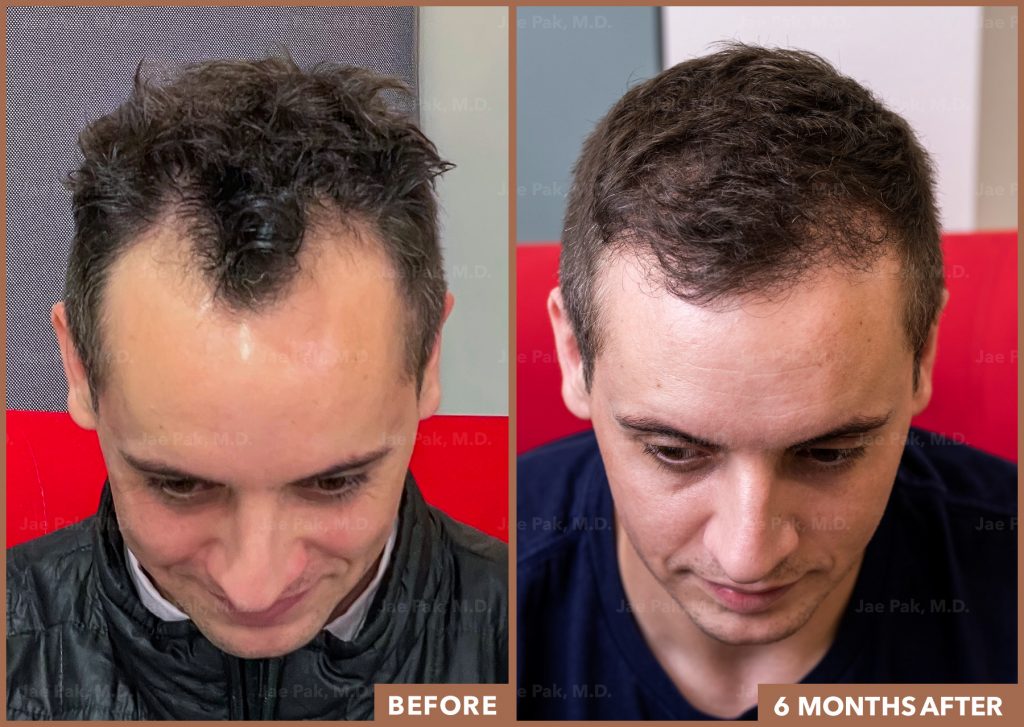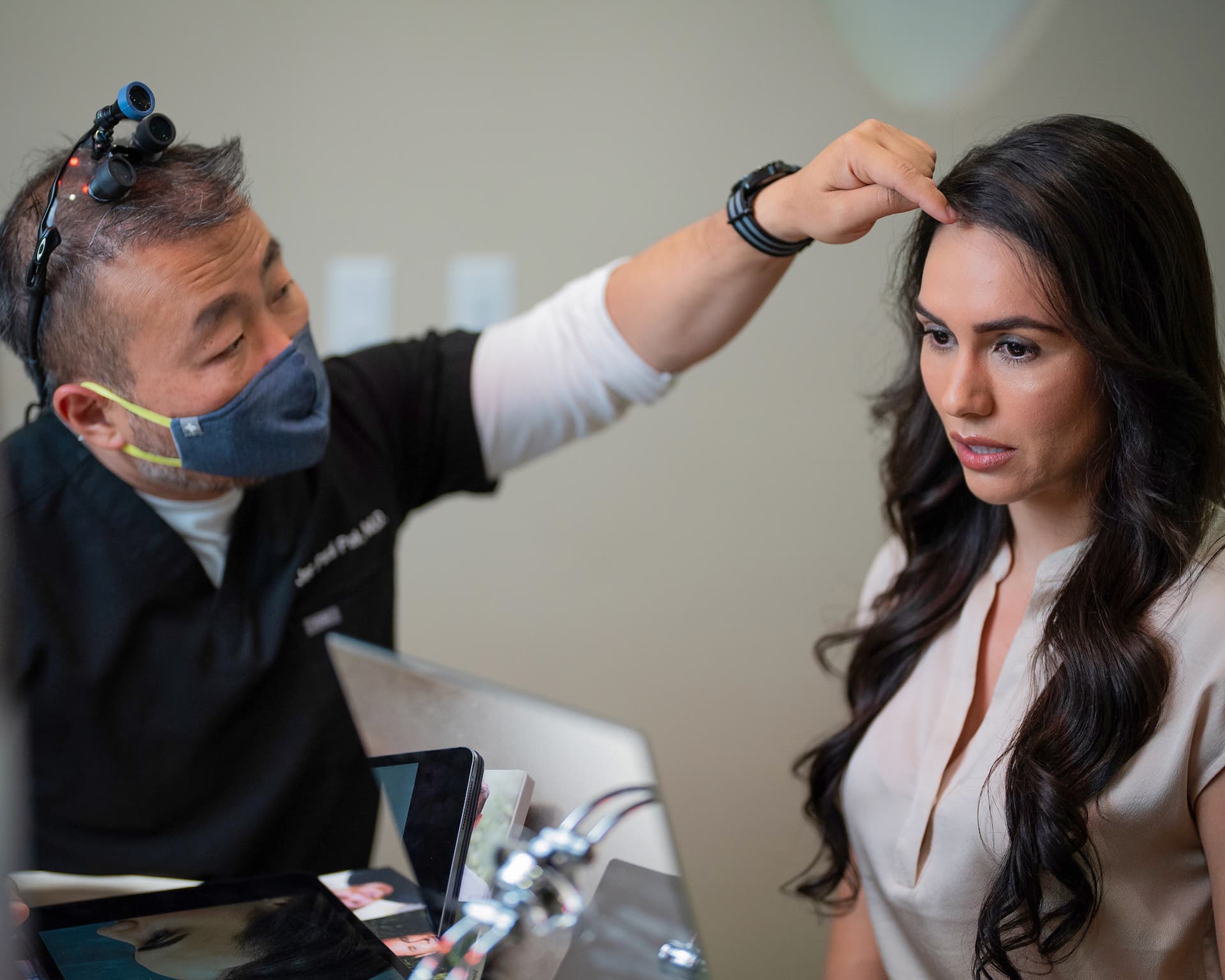
Before and After 6 Months – Hair Transplant Surgery
The widow’s peak is a subject of much controversy in the hair restoration field. Some patients are perfectly happy with this triangular segment of hair that stems from the center of the hairline, while others want to have it altered or removed entirely.
From a physician’s perspective, following through with widow’s peak removal procedures is not cut and dry, since there are many ways to approach the process.
The point is that every case is unique when it comes to managing widow’s peaks, and as with all types of cosmetic procedures, a custom strategy is a must for anyone looking to proceed with the plan.
Let’s learn all the relevant facts about widow’s peaks and what they mean, then talk about the best non-permanent and permanent ways to have a widow’s peak altered or removed altogether.
Due to their unique shape and associations, widow’s peaks can be polarizing among the population. Some people love having a distinguishing feature on their hairlines that sets them apart, while others don’t enjoy the appearance of the shape at all.
But in terms of the medical meaning of a widow’s peak, there can be a few different interpretations. Let’s discuss those first before getting into treatment options.
In nearly all cases, both male and female, a widow’s peak results from genetic factors rather than conditions in the environment or lifestyle choices.
These shapes tend to develop very early on in the stages of a youthful hairline, meaning that children can show signs of widow’s peaks before any further maturation of the hairline.
The key indicator of a normal widow’s peak is symmetry and position on the forehead. For younger individuals, the peak should be directly in the center of the forehead and dip down slightly, even if the hairline is otherwise even and flat.
In some cases, the peak may be more exaggerated and rounded, creating an M-shaped pattern towards the crown on either side of the forehead.
Rarely does a widow’s peak happen as a result of reactions to illness, medication, or long-term health conditions. This style of hairline is typically maintained throughout a person’s life, unless they experience alopecia of some kind or decide to follow through with removal.
This is the big question for men who find their widow’s peak becoming more prominent with age. Referencing the Norwood chart of male pattern balding progression, we see that a widow’s peak is indeed an early indicator of further hair loss, or simply a mature hairline in full form.
What matters more is the rate of change observed on the hairline, for example, if a widow’s peak appears out of nowhere over the course of a year or two. Considering that more than two-thirds of men experience balding at some point in their lives, a “new” widow’s peak could be cause for concern.
When coupled with other signals of receding hairline such as peaking temple hair and general thinning across the scalp (bald spot development), a widow’s peak might be an indication of more male pattern balding to come.
In this case, widow’s peak “removal” is more accurately viewed as a reconstitution of the hairline through various treatments, rather than taking away a widow’s peak while retaining the structure of the natural hairline.
Connecting with a restoration professional ASAP is the correct course of action, with a focus on medicines and therapeutics before considering surgery.
When it comes to people’s preferences, there’s often no convincing them otherwise – someone who wants their widow’s peak removed is going to figure out a way to do it sooner than later, and there’s nothing wrong with that.
Like with any type of cosmetic procedure – permanent or otherwise – there are always some risks to consider. It’s a spectrum, of course, and patients should be aware of all potential outcomes, good or bad, before committing to a game plan.
In the case of widow’s peak removal, however, risks are generally quite minimal beyond the typical issues of swelling, bleeding, or minor discomfort following treatments.
As we’ll discuss next, there are several effective and non-invasive ways to address a widow’s peak, and it’s always advised that patients meet with a trusted hair restoration pro to discover the best solution available.
For patients who want to see what life is like without a widow’s peak for a few days or weeks, non-permanent removal methods are a perfect place to start.
After all, someone may not realize they like their widow’s peak until it’s gone! Always try out one of the following methods before going all-in with a permanent removal method.
This trio of techniques are the classics of non-permanent hair removal, and there’s no reason why they can’t be applied when configuring the shape of one’s hairline and widow’s peak.
Start by shaving the area with a standard razor and moisturizing cream or foam, being careful to avoid carving into the hairline any further than necessary.
If you achieve your desired look from shaving, take a mental (or actual) picture as a reminder of where you want your hairline to be in the future. From there, you can set regular appointments with a waxing technician or hair stylist who will keep your widow’s peak at bay in the short term.
Remember that hairlines and preferences will change over time, so these treatments are ideal for younger individuals who just want to experiment with various looks and not make a long-range commitment.
These types of creams and lotions may be more effective and semi-permanent, but also come with some dangers during the application process.
Only use these products if you’re 100% certain in your abilities to manage the substance and apply it for the proper amount of time.
Professional application may be advised if you’ve never used a depilatory product prior to this.
For those who have spent months or years trimming and shaving away their widow’s peaks, a more permanent plan is in order. Here are your options for surgical treatments that can make a widow’s peak disappear for good.

As mentioned earlier, procedures like hair transplant surgery can be utilized to create a rejuvenated hairline that reduces the appearance of a widow’s peak or hides it entirely.
This type of procedure is common in men who are experiencing the later stages of a mature hairline and beginning to see the onset of a receding hairline with widow’s peak as the most prevalent central feature.
In cases like these, lower volume hair transplant procedures such as Follicle Unit Excision may be most appropriate since the high volumes yielded by FUT strip surgery could be more than necessary to fill in gaps or diminish the M-shaped hairline.
Again, surgery of this sort should only be considered following natural supplements, therapeutics, and lifestyle adjustments to combat hair loss early on. However, a minimally invasive operation like FUE can be the perfect fit for many men from age thirty and beyond.
This treatment has grown more popular over the years as a hair removal method for nearly anywhere on the body.
The technology targets the root of the hair with high-powered lasers, which disrupt and eventually cease the lifecycle of follicles at their foundations.
Laser hair removal must be done several times over multiple treatments to ensure lasting effects, and the price can range up to over $1000, depending on the clinic. But with minimal discomfort, virtually no risk, and lasting results, a well-done laser treatment regimen can ensure that a widow’s peak will not return.
Rather than lasers using heat to target follicle roots, this method uses an ultra-thin needle to probe into individual follicles and zap them with an electric current.
This causes the life cycle of each follicle unit to end its anagen, or growth phase.
Electrolysis requires multiple sessions and can be slightly more uncomfortable than laser therapy, but the procedure is generally more affordable, especially for a minor target area like a widow’s peak.
Electrolysis will also not work for very light pigmentation hair so laser therapy may be necessary for patients of this type.
Millions of people wear their widow’s peaks with pride and would never change a thing about their hairlines. On the other hand, some folks just want an even, uneventful hairline and are willing to undergo the process to get there.
No matter where you stand with your own widow’s peak, always be sure to connect with a hair restoration professional like Jae Pak, MD before taking the next step.
Sources:
Widow’s Peak Significance | NIH
Speak with Jae Pak, M.D. today!
Request a Consultation